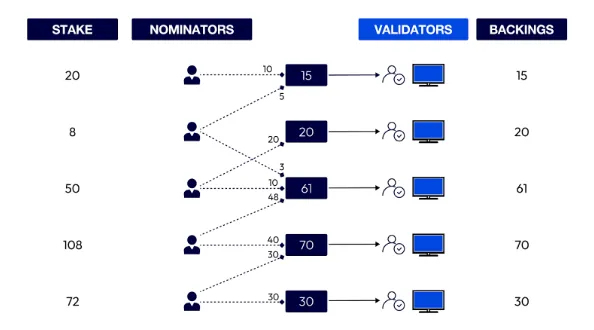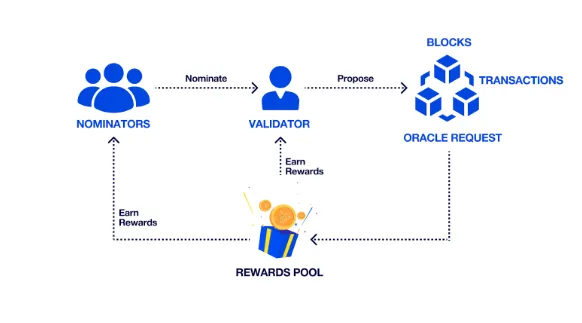Consensus Explained

The Election Process
The election process is done in an NPoS manner, and the rewards are calculated based on the ESG scores. This incentivizes a sustainable and ethical selection of validators that can positively contribute to the consensus protocol. Hence, nominators are expected to perform appropriate due diligence when selecting validators and diversify their nominated stake across multiple validators to secure the network and create a sustainable blockchain ecosystem.
The consensus protocol requires participating nodes (validators) in the consensus, to put monetary resources at risk as a security deposit. It calculates an active set of validators based on the overall amount of nominated stake that backs them. This calculation includes the validators’ own stake and the stake of other coin holders backing the validator. An important element of this algorithm is the financial incentive scheme that rewards validators who adhere to the protocol, while punishing negative behavior or misconduct.

The above diagram depicts the election input process for the SPoS mechanism. Nominators have varying amounts staked directly to the Validators. The nominators’ staked amount provides accountability for the actions of Validators. The main objectives of this election process are ensuring decentralization, providing proportional and justified representation of validators, and providing robust security through full support. As a result of proportional and justified representation, slots can be provided to validators directly proportional to their nominations. The nomination amounts contribute to the overall number of coins available to stake on the validator and the higher the stake amount, the higher the probability for the validator to be elected into an active set. At the conclusion of every era, validators are elected (one era = one hour). The set of validators can be amended along with each era.

Reward Calculation and Distribution
Reward payments can be processed when an era ends. The total reward of an era is the dividend of the total coin supply and the total number of coins staked by nominators within that era. The core emphasis on rewards is to allow and encourage users to stake coins at a specific rate. The users are requested to provide a payout of their personal rewards for reward redemption.
Consider the following example:
-
Rewards per era: 200 5ire Coins
Era (1 Era = 1 hour)
Commission fee of the validator: 10%
Five nominators (A, B, C, D, E) with the following stake each:
-
A: 20 5ire
-
B: 10 5ire
-
C: 40 5ire
-
D: 60 5ire
-
E: 70 5ire
→ Total stake backing the validator: 200 5ire
Rewards: 200 5ire (total rewards) — 20 5ire (validator commission fee) = 180 5ire (remaining for nominators)
-
-
Rewards per nominator:
-
A: 180 5ire (remaining rewards) x [20 5ire (stake of A) / 200 5ire (total stake of validator)] = 18 5ire
-
B: 180 5ire (remaining rewards) x [10 5ire (stake of B) / 200 5ire (total stake of validator)] = 9 5ire
-
C: 180 5ire (remaining rewards) x [40 5ire (stake of C) / 200 5ire (total stake of validator)] = 36 5ire
-
D: 180 5ire (remaining rewards) x [60 5ire (stake of D) / 200 5ire (total stake of validator)] = 54 5ire
-
E: 180 5ire (remaining rewards) x [70 5ire (stake of E) / 200 5ire (total stake of validator)] = 63 5ire
-
Rewards and Slashing
Integrated into the staking module is the reward and slashing module, which focuses on rewarding essential activities and penalizing any absence or misconduct during the specific era. The stakeholders eligible for a payout must claim rewards after leveraging the call of ‘payout_stakers’ before they expire. A network participant has the authority to make this call that can automatically provide rewards to validators and nominators. If any misconduct is identified, slashing will occur. A specific value will be subtracted from the balance of the validator and all the participating nominators that were required to vote for the given penalized entity.